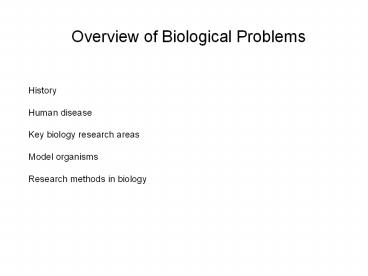Overview of Biological Problems PowerPoint PPT Presentation
1 / 27
Title: Overview of Biological Problems
1
Overview of Biological Problems
History Human disease Key biology research
areas Model organisms Research methods in
biology
2
A brief history of biological discovery 1838
modern cell biology begins with cell theory
(Schleiden and Schwann) 1865 modern genetics
begins with basic laws of heredity (Mendel) 1875
evolutionary theory (Darwin) 1953 structure of
DNA determined (Watson and Crick) 1960 first
crystal structure of protein (Kendrew and
Perutz) 1972 first recombinant DNA molecules
(Berg, Cohen, Boyer) 1977 rapid sequencing
techniques (Gilbert and Sanger) 1994-95 DNA
arrays introduced (Fodor, Brown, Davis) 1995
first complete genome sequences for
organisms 2001 first draft of human genome
sequence reported
3
Overview of Biological Problems
History Human disease Key biology research
areas Model organisms Research methods in
biology
4
- Human disease
- Inherited disease (Cystic fibrosis)
- Somatic disease (Cancer 17m deaths)
- Communicable disease (AIDS, etc 20m deaths)
5
Overview of Biological Problems
History Human disease Key biology research
areas Model organisms Research methods in
biology
6
Human Biology Genome sequence Evolution Gene
expression Regulation Cell biology Cancer is
loss of cell growth control Development 1 cell
-gt 1013 cells Immunity 10 cells Neurobiology
Cognition
7
Human Biology Genome sequence Evolution Gene
expression Regulation Cell biology Cancer is
loss of cell growth control Development 1 cell
-gt 1013 cells Immunity 10 cells Neurobiology
Cognition
8
How are Genes Regulated? DNA-binding Activators
Are Key To Specific Gene Expression
Chromatin modification complexes
Transcription initiation apparatus
Activators
Gene
9
Transcriptional Regulatory Networks
Transcriptional regulatory networks describe how
a gene expression program is controlled by
transcriptional regulators across the
genome
10
Transcription factors implicated in human disease
Cancer AML1, p53, PLZF, PML, Rb, WT1
Immunological Defects RFX5, WHN
Developmental Defects GATA1, VDR, CRX, CBP, MeCP2
Obesity PPARgamma, SIM1
Diabetes IPF1, HNF4a, TCF/HNF1, TCF2
Hypertension NR3C2, GCCR
Jimenez-Sanchez et al, Nature, Feb. 2001
11
Human Biology Genome sequence Evolution Gene
expression Regulation Cell biology Cancer is
loss of cell growth control Development 1 cell
-gt 1013 cells Immunity 10 cells Neurobiology
Cognition
12
Yeast cell cycle
Growth
Sister chromatid separation
DNA replication
Budding
13
alpha 0 alpha 7 alpha 14 alpha 21 alpha
28 alpha 35 alpha 42 alpha 49 alpha 56 alpha
63 alpha 70 alpha 77 alpha 84 alpha
91 alpha 98 alpha 105 alpha 112 alpha 119
Yeast Cell Cycle Gene Expression Program
Mbp1/Swi6 Swi4/Swi6
800 Genes
Mcm1/Fkh2/Ndd1
Ace2, Swi5, Mcm1
Affymetrix Microarray
1/3 1
3
Spellman et al. and Cho et al., 1998
1 3.5 gt5
14
Cell Cycle Regulatory Network
Target Gene Key Activators Cyclins
Activators that function during one stage of the
cell cycle regulate activators that function
during the next stage This serial regulation
of transcriptional activators forms a connected,
circular regulatory network
Yeast genome regulation
15
Human Biology Gene expression Regulation Cell
biology Cancer is loss of cell growth
control Development 1 cell -gt 1013
cells Immunity 10 cells Neurobiology
Cognition Evolution Genomics
16
History of Selected Human Diseases
tuberculosis
measles
smallpox
malaria
plague
AIDS
2000BC
1000BC
2000AD
1000AD
17
World Mortality WHO 2000 Communicable diseases
17,380,000 Acute lower
respiratory 3,963,000 HIV/AIDS 2,673,000 Diarr
hoeal diseases 2,213,000 Tuberculosis 1,669,000
Malaria 1,086,000 Measles
875,000 Tetanus 377,000 Pertussis
295,000 Meningitis 171,000 Syphilis
153,000
18
Communicable Disease Selected Human Pathogens
Bacterial
Viral
S. typhimirium
M. tuberculosis
HIV-1
Echovirus
L. monocytogenes
S. aureus
Influenza Virus
Herpes Virus
19
Host Immunity
Dendritic cells Macrophages
20
Overview of Biological Problems
History Human disease Key biology research
areas Model organisms Research methods in
biology
21
Model Organisms Bakers yeast (S.
cerevisiae) Nematode (C. elegans) Fruit fly
(Drosophila) Mouse Non-human primates
Each model organism has distinct advantages for
studying specific biological problems
22
Overview of Biological Problems
History Human disease Key biology research
areas Model organisms Research methods in
biology
23
Research methods in biology Genetics Biochemis
try Molecular Biology Cell Biology Genomics Pr
oteomics
24
Overview of Biological Problems
History Human disease Key biology research
areas Model organisms Research methods in
biology
25
Transcriptional Regulatory Networks
Transcriptional regulatory networks describe how
a gene expression program is controlled by
transcriptional regulators across the
genome
26
Genome-wide Gene Expression (mRNA) can be
Measured with DNA Microarrays
Transcription apparatus
mRNA
Gene
RNAPII
TFIIH
Activators
ATGC TACG
hybridization
label
mRNA
27
Functional Genomics High-throughput
technology
DNA sequence (automated sequencers) RNA
expression (DNA microarrays) Protein content (2-D
gels/mass spectrometry, other arrays) Protein
location (DNA-bound, microscopic
visualization) Protein-protein interaction
(2-hybrid, IP-mass spectrometry, FRET) Protein
structure (Protein structure initiative,
prototypical structures)
Analysis and information technology
Databases for data sharing and analysis Analysis
tools and methods

